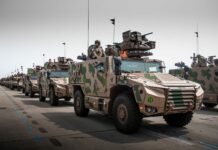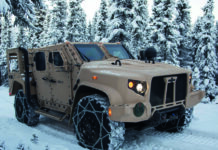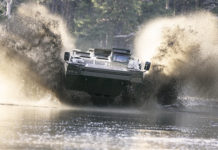The wheeled armoured vehicle sector provides potential customers with a wealth of choices for virtually all conceivable requirements.
The vehicle range includes variants in 4×4, 6×6 and 8×8 configuration. Selecting the appropriate vehicle solution is dictated by the mission(s) that are to be carried out, the operational environment, and the weight category of the vehicle; this is governed by the mobility required versus the protection needed, in addition to the firepower solutions considered to be essential. A margin for growth should also be included in order to accommodate new equipment and protection fits. These elements should be factored into the overall vehicle package that the operator can maintain and support through the service life of the vehicle. And all of this needs to be at an affordable cost for the operator.
If affordability is important and mission criteria can still be met, the acquisition of a 4×4 protected vehicle solution is perfectly appropriate. The Turkish defence industry has developed a complete range of wheeled armoured vehicle solutions and has been very successful in export markets. In South America, 20 Cobra II 4×4 systems and more recently, 15 Ural 4×4 vehicles, designed for internal security applications, were delivered to Ecuador by Turkish defence firm Otokar. As an aside, it appears that Otokar supplied Ukraine with at least 20 Cobra II vehicles in the second quarter of 2023.
Another Turkish armoured vehicle company, Nurol Makina, achieved an important breakthrough into the European NATO marketplace with the decision by Hungary to acquire the Ejder Yalçin 4×4 tactical armoured vehicle, known as the Gidrán in Hungarian service. Since 2021, Hungary has received some 50 Gidrán vehicles out of an original acquisition objective of 300 units. At the end of October 2023, Hungary and Nurol Makina signed a Memorandum of Understanding covering the local production of the Gidrán in Hungary, with the implication that a substantial number of vehicles, potentially more than the original programme objective, could be acquired.
These contracts illustrate that the Turkish defence industry has the capability to be competitive at the 4×4 end of the wheeled armour marketplace. A new contract from another European NATO country, in this case Estonia, indicates that Turkish industry is also competitive in the 6×6 vehicle sector. In October 2023, the Estonian Centre for Defence Investments (ECDI) announced that it had awarded contracts to Nurol Makina and Otokar for 4×4 and 6×6 armoured vehicles. The contract value was EUR 200 million and includes vehicles, documentation, training, special tools and spares. In total, 230 armoured vehicles will be acquired, plus four more for the Explosive Ordnance Disposal Centre of the Estonian Rescue Board.

Credit: Otokar
According to the ECDI, the two Turkish companies were selected after evaluating proposals from nine different companies from six different countries. First vehicle deliveries will take place in 2024 and all deliveries will be complete by 2025. ECDI notes that contract validity is for 10 years, and this could potentially cover the acquisition of more vehicles and spare parts if required.
Nurol Makina will supply their EWS 4×4 vehicle to Estonia; the vehicle is available in nine separate variants and an extended wheelbase variant is available in the form of the NMS EWB 4×4. Otokar disclosed that the contract value of their sale to Estonia was EUR 130 million and that this covered the acquisition of the ARMA 6×6 vehicle. The ARMA is a modular system that can be configured for multiple mission requirements, such as standard APC, IFV with a turret-mounted 25 mm cannon, fire support variant with a 90 mm cannon and a variant for explosive ordnance disposal (EOD). According to Otokar, five different countries already operate the ARMA. Both the EWS and the ARMA in Estonian service will be equipped with a single 12.7 × 99 mm NATO M2 heavy machine gun.
International choices
Estonia’s decision to meet its 4×4 and 6×6 wheeled armour needs with Turkish vehicles is significant, as is the decision by Hungary to opt for Turkish 4×4 vehicles and to manufacture them under licence. All of this proves that the level of competition for wheeled armour orders in Europe is intense and that European manufacturers are not guaranteed success in what should be relatively approachable markets. Broaden the focus to global markets and even there, the level of competition has considerably increased in recent years. The fact of the matter is that there are a number of credible armoured vehicle designs ready to meet any requirements that might emerge.
There is undoubtedly an abundance of 4×4 wheeled armour options; equally, there is plenty of choice when 6×6 vehicles are evaluated. For example, the 6×6 VBTP-MR Guarani from Brazil, based on an Iveco design, benefits from large Brazilian orders and has started to achieve export success. Another option for a 6×6 solution comes from Hyundai Rotem in the Republic of Korea (ROK). The company won the competition to provide the ROK Army with new 8×8 (K808) and a 6×6 (K806) wheeled armoured vehicles; once again, an existing domestic order base strengthens the ability to compete in the export market.
Indonesia has its own 6×6 solution in the form of the PT Pindad Anoa; this vehicle is clearly influenced by the French Arquus Véhicule de l’avant blindé (VAB) and it even uses the Arquus VAB Mk3 driveline. Primarily aimed at meeting the needs of the Indonesian military, the Anoa has also been offered to meet a 6×6 vehicle requirement in Malaysia. France has always been a strong supporter of the 6×6 format and there are numerous solutions on offer to meet both domestic programme requirements and export opportunities.
The Arquus VAB has been extremely successful in export markets over the years and the latest version, the VAB Mk3, is aimed at export markets where the requirement is to replace older generation 8×8 vehicles such as the BTR-60/BTR-70 and BTR-80. A high-performance 6×6 vehicle can easily replace these old 8×8 types and offer far higher operational performance levels. Customers with older generation VAB vehicles can opt to upgrade their existing fleets, for example Qatar established a VAB rebuild facility, improving protection and other characteristics, and boosting automotive performance via the installation of the VAB Mk3 driveline. Another French 6×6 solution comes from KNDS with development of the TITUS, a new range of vehicles based on a Tatra truck chassis. The vehicle can be used for both military and paramilitary applications. Thus far, the main customer is Czechia which has some 62 vehicles in service.
The French Army has long been persuaded of the utility of wheeled armoured vehicle solutions and one of the leaders in this field was Panhard (now part of Arquus), which produced the 4×4 AML family of vehicles in the 1960s. By the time production ended in the late 1980s, thousands of vehicles had been produced for export customers in Africa, the Middle East and South America, with the French Army reportedly acquiring some 900. When the French Army sought a replacement, they opted for a 6×6 vehicle that was more heavily armoured for reconnaissance and combat missions. This resulted in the AMX-10RC, with the French Army taking 300, Morocco 108 and Qatar 12; subsequently, French vehicles were upgraded to the AMX-10RCR configuration. France has donated AMX-10RC/RCR vehicles to Ukraine and will gradually retire the vehicle as it is replaced by the new Jaguar vehicle.

Credit: Armée de Terre
While the AMX-10RC met the majority of French Army needs, it was too heavy to support intervention operations in Francophone Africa, where French troops and equipment needed to be deployed rapidly. This saw the French Army turn to Panhard, and their successor to the AML, the ERC-90 Sagaie, a 6×6 vehicle mounting a 90 mm gun. The Sagaie will also be replaced by the Jaguar.
The new wheeled vehicles being acquired under the French Army Scorpion programme include the Véhicule Blindé multi-rôle léger (VBMR-L) Serval, a 4×4 system supplied by KNDS and Texelis, with 978 vehicles due to be acquired by 2035. An additional 1,060 Serval vehicles are due to be acquired under the Véhicule léger tactique polyvalent protégé programme. It is the 6×6 vehicles in the Scorpion programme that are of interest in this article; these two vehicles are the Véhicule blindé multi-rôles (VBMR) Griffon and the Engin blindé de reconnaissance et de combat (EBRC) Jaguar.
According to the Direction générale de l’armement (DGA), the French defence acquisition authority, the French Army received 16 Griffon vehicles in October 2023, 13 of which were troop transport variants and three were command post variants. The programme schedule is that 887 Griffons will have been delivered by the end of 2025. As of end October 2023, the French Army had received 443 Griffon VTT troop transports, 79 Griffon EPC command variants and 11 Griffon VOA artillery observation variants. Another variant of the Griffon for the French Army is the Mortier embarqué pour l’appui au contact (MEPAC) mortar carrier armed with a 120 mm Thales 2R2M mortar, 54 of which are on order. Belgium is the first export customer for the Griffon and also for the Jaguar, with their Capacités Motorisée (CaMo) programme for the Belgian Land Component. Under CaMo, Belgium has ordered 60 Jaguars and 382 Griffons, as well as two batteries of the MEPAC mortar vehicle.
As previously noted, the EBRC Jaguar is replacing the AMX-10RC/RCR and the ERC-90 Sagaie, as well as the anti-tank variant of the VAB with HOT missiles in the French Army. Jaguar is a 25-tonne vehicle, with a three-person crew; in total, 300 Jaguars are to be acquired by 2030. Particularly impressive is the firepower available to this vehicle - the turret mounts a CTA International CT40 40 mm cannon, and also mounts two MBDA Akeron-MP anti-tank missiles with a 7.62 mm machine gun in a Hornet remote weapon station on the turret roof; the Hornet is also a standard fit on Griffon vehicles.

Credit: Etat major des armées
Multinational progress
Patria in Finland has built a significant presence in both the 6×6 and 8×8 wheeled armour sectors. Their 8×8 AMV has been particularly successful, with substantial numbers built under licence in Poland as the KTO Rosomak. Ukraine will order an initial batch of 100 Rosomak vehicles, and intends to purchase 100 more. South Africa also produces the AMV under licence, with other AMV customers including Finland, Croatia, Slovakia, Sweden and the United Arab Emirates (UAE). In December 2022, the AMV XP was selected by the Japan Ground Self-Defense Force (JGSDF) for the wheeled armoured personnel carrier (WAPC) requirement to replace the existing Type 96 8×8 vehicle in JGSDF service. At the end of August 2023, Patria signed a licence production agreement with Japan Steel Works (JSW) to produce the AMV XP in Japan.
Prior to the AMV, Patria was best known from the 1980s onwards for its 6×6 vehicles such as the XA vehicle family in the XA-180/XA-185/XA-186/XA-188 and XA-200 variants. The first customer was Finland, with seven countries also adopting the vehicles, which were highly valued in peacekeeping operations. Patria has since carried out service life extension programmes on Finnish and Swedish XA vehicles.
More recently, Patria decided to build a successor 6×6 vehicle, building on what they had learnt from the XA and the AMV, resulting in the Common Armoured Vehicle System (CAVS). This provided the basis for a multinational programme, as in January 2020 Finland and Latvia agreed to define a new 6×6 vehicle, which was the CAVS, with Patria as prime contractor. In August 2021, the CAVS programme entered the acquisition phase, with Latvia placing orders for more than 200 vehicles with first deliveries taking place in October 2021. All of the CAVS vehicles will be built by Patria in Hämeenlinna, Finland with Finland signing a Letter of Intent to cover the acquisition of 160 CAVS vehicles. In January 2022, Finland ordered three pre-series CAVS vehicles for test and evaluation purposes; these were delivered in mid-2022.

Credit: Patria
At the end of 2021, Sweden announced that it was joining the CAVS programme, and in June 2022 the Swedish defence materiel administration (FMV), the Ministry of Defence of Finland, the Ministry of Defence of Latvia and Patria signed an agreement under which Sweden would join the CAVS R&D programme. Germany signed a Statement of Intent in June 2022 to join the CAVS programme, then in April 2023 they officially joined the programme. April 2023 also saw the Swedish FMV sign for 20 CAVS vehicles, to be known as the Pansarterrängbil 300 in Swedish service; the eventual requirement will be for ‘several hundred’ vehicles.
In June 2023, the Finnish Defence Forces Logistics Command signed an agreement with Patria covering the acquisition of a first batch of 91 CAVS vehicles, with the option of a further 70. Finally, the first vehicles for Sweden were handed over at the Ground Combat School in Kvarn on 26 October 2023.
From the starting point in 2020, CAVS has evolved into a four-nation multinational programme, which unlike most multinational programmes seems to be exceedingly well managed, as demonstrated by how rapidly vehicles are delivered. With the benefit of a strong order base from the four partners, CAVS provides the basis to be both price and performance competitive in international 6×6 wheeled armour markets.
The wheeled armoured vehicle market remains incredibly competitive in the 4×4, 6×6 and 8×8 sectors. Supplier diversity is the name of the game here, as multiple suppliers from multiple countries have numerous vehicle solutions available to meet virtually any conceivable requirement. In investigating the validity of this range of vehicle solutions, it is, inevitably, up to the customer to make the right choice.
David Saw




![The continuing evolution of tube artillery The 8×8 variant of the CAESAR SPH on display at the Eurosatory 2024 exhibition. [Tank Encyclopedia, courtesy photo]](https://euro-sd.com/wp-content/uploads/2025/08/caesar-8x8-at-eurosatory-2024-Kopie-218x150.jpg)
![Desert tracks: The Gulf AFV market Seen here in service with the Kuwait Land Forces, the M1 Abrams family is the most numerous MBT in the inventories of Gulf militaries. [US ANG/MSgt Matthew Keeler]](https://euro-sd.com/wp-content/uploads/2025/07/01_M1-Abrams_US-ANGMSgt-Matthew-Keeler-Kopie-218x150.jpg)





